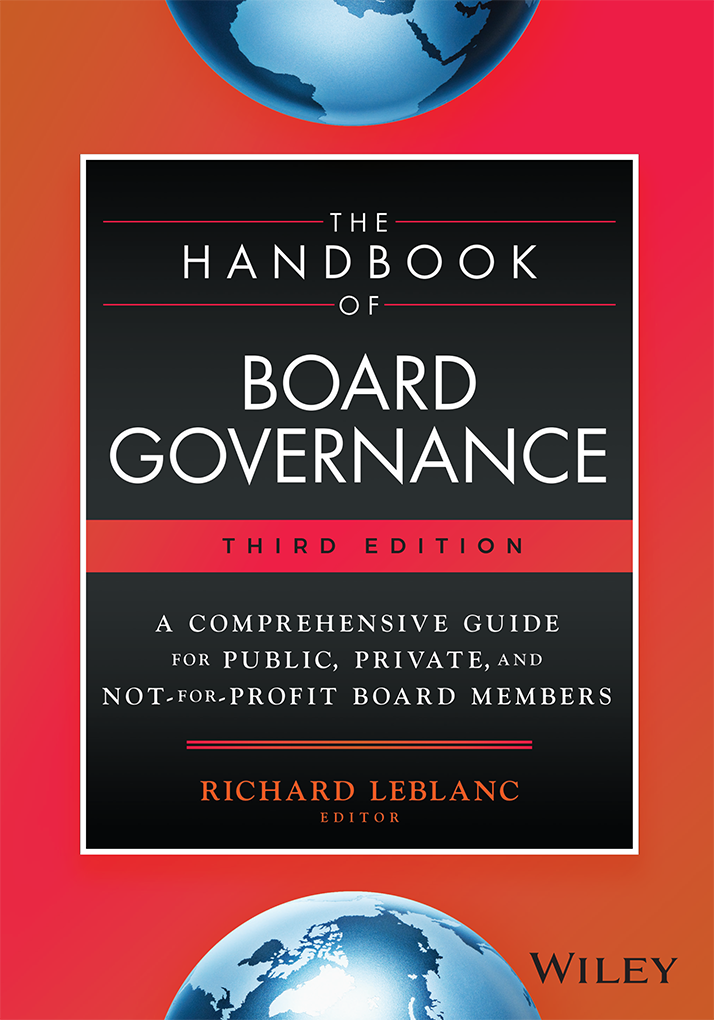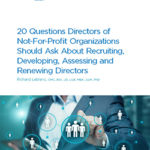Several memories stand out in my mind. One was the dominant CEO who kept interrupting me to tell me how effective he and “his” board were, despite the results of my assessment (the board was in trouble with regulators and the CEO later resigned). Another was a very rich and famous director asking me to leave his office when we debriefed on the peer review, which indicated how his colleagues thought his contribution was (he too resigned). Another was a director who actually resigned from the board ahead of time when he found out I was going to do the review. Another was a chair of a governance committee who viewed my questions and then decided against the review (he was later in the news for conflicts of interest).
I have seen all kinds of data – directors who fall asleep at meetings. CEOs who pound tables. CEOs who funnel information. Directors who are out of their depth. Directors who despise other directors. Bullying, cliques, factions, sexism, conflicts and denial. The most fascinating to see is the body language, process, relationships and dynamics – this can make or break a board regardless of structure and protocols. An intransigent CRO or ineffective risk committee chair can take a company down. I have also assessed some of the best performing boards – led by terrific leaders who spend enormous effort at getting the directors and process just right. Some have won national awards over the years they are this good.
So I have learned a thing or two.
First, why would any board do an “external” board review to begin with? Simple. Self interest. Boards assessing themselves are analogous to students marking their own exams. It’s an inherent conflict to assess your own work. It’s even worse if management facilitates (which happens most of the time a “self” review occurs) as they have the most to gain by a soft review.
Mainly, however, external board reviews are often poorly done. Why? What makes for a good external board review? Four key elements.
Who is your client?
Your client is not the CEO. Your client is not the general counsel, nor the corporate secretary, nor any manager for that matter. Management should not unduly influence you. If you conduct a governance review properly, the board’s interests could – and sometimes should and will – be adverse to those of management, whom the board controls. So you cannot act for simultaneously opposing interests. If you or your firm does business with management, or seeks to, or has done in the past, you are conflicted and should not do the review, no matter how you try and justify it.
Your client is also not the chair of the board. A good board review will assess the chair’s performance and he or she is likely the problem if the board is poor.
Your client is the chair of the governance committee (or its equivalent) and the committee as a whole, who ultimately reports to shareholders, similar to the auditors being accountable to the audit committee. If you do not work directly with and for the governance committee, the review will likely suffer or fail.
Garbage in, garbage out
Next, the review itself. The vast majority of approaches are superficial, do not reflect best practice, use the wrong scale, and are heavily biased. Unfortunately, these “surveys” get perpetuated and become the lowest common denominator. They are highly imprecise and lead to misleading results. There is a false sense of reality when the board “agrees” or “strongly agrees” to a majority of ill-defined performance metrics. The analogy to “happy-face” questionnaires is “pat-on-the-back” interviews. The tough questions are not asked. Garbage in, garbage out.
The review becomes a one-sized-fits-all, check-the-box pain, no better than those of external proxy advisory firms and rating agencies. Directors are skeptical, rightly so because what really matters is not being measured and what doesn’t, is.
The board of a bank is not the same as the board of a hospital or high tech start up. Reviews need to be best practice, highly customized and rigorous. They need to span silos. Lawyers, accountants and HR advisors don’t have competencies and market permission in cross-silos and default professionally to their own. The result is even more compliance box ticking.
Importance of 360 feedback
If a board is stale, management knows. If a director is not performing, directors know. Each director and reporting management should opine on other directors. The learning and self-development here is tremendous and counteracts a board or director thinking it, he or she is better than others do. It is very difficult if not impossible to do a peer assessment internally. Directors default into collective group-think (read: denial) because their responses will be seen internally. A good peer review will include self, peer and board assessment, so each director knows how he or she performs relative to his or her own perception, other directors and the board as a whole. The peer review becomes a developmental and recruitment tool.
Reporting and debriefing
The vast majority of reporting to shareholders by listed companies on the results of board reviews is superficial, wholly inadequate and boilerplate. Companies have a vested interest in making it this way. This will not change without greater prescription and enforcement by market regulators and shareholders.
Perhaps the weakest link for a board review however is internal reporting, implementation and action taken based on the review. Feedback should be provided to each individual director and debriefings should occur to discuss development, priorities, committee and board reform, and tough discussions – such as leadership and behavioural change and director retirement. A good review effects behavior. Some of the areas include knowledge of the business, judgment, communication, integrity, constructive challenge, willingness to act, thinking skills, financial acumen, interpersonal/teamwork and commitment. These are very specific skills that each director needs to possess for the board to be effective. One director can unduly effect an entire board dynamic and decision. Governance committee chairs and I have had tough but candid discussions and coaching with directors based on these outputs. It is not easy, but without proper data and leadership, directors on the receiving end either refuse to acknowledge or do anything about it.
Conclusion: Canada ahead of US and UK but they are catching up
To Canada’s credit, we have had to explicitly recruit and assess individual directors on the basis of competencies and skills since 2005. We have also not had enormous financial failures or bailouts. The US and UK have. Imagine that – up until the financial crisis, you could sit on a risk committee of a US bank and not know anything about risk or banking. The US changed its rules since then, mandating that directors need to disclose their qualifications, which is not quite the same as directors being assessed. (Lawyers will skillfully list bullet points about past job titles.) In the UK, their Code has changed stating that for all listed companies, external board reviews have to occur at least every two or three years. This is a step in the right direction.
Posted by Richard Leblanc on Nov 11, 2011 at 11:04 pm in Member Selection, Competencies and Commitment, Performance and Evaluation |












